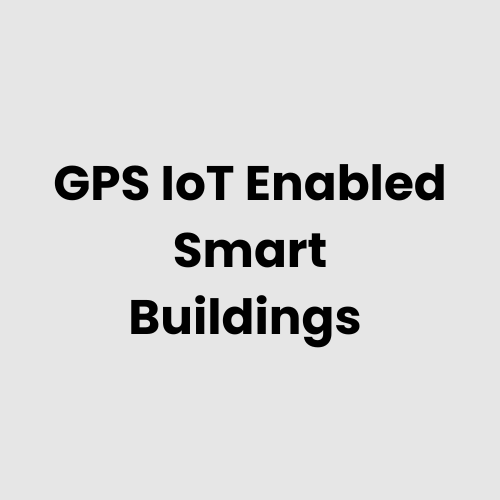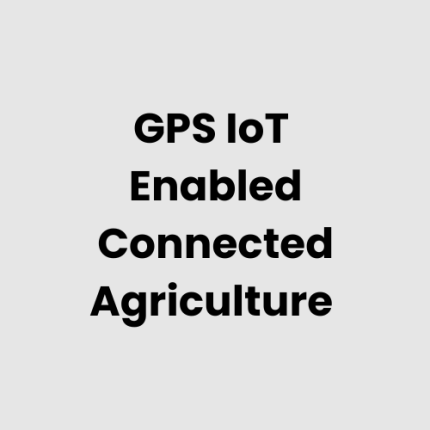GPS IoT Enabled Smart Buildings
Explore the technical architecture, hardware, deployment considerations, and cloud integration for GAO Tek’s GPS IoT Enabled Smart Buildings System to enhance building management efficiency.
Description
Technical Architecture
The GPS IoT Enabled Smart Buildings System integrates a network of interconnected devices and sensors to optimize building operations such as energy management, security, HVAC, lighting, and more. The system architecture includes a combination of edge devices, local servers, and cloud infrastructure to ensure real-time data collection, monitoring, and analytics for improved operational efficiency. The system can be configured for scalability and flexibility to suit various building sizes and types, offering seamless communication between hardware and software.
Hardware of the GPS IoT Enabled Smart Buildings System
- Smart Sensors
- Temperature, humidity, and motion sensors
- Light and CO2 sensors for energy optimization
- Occupancy sensors for smart lighting and HVAC control
- Environmental monitoring sensors
- Edge Devices
- IoT gateways for connecting sensors to cloud platforms
- Wireless communication modules (e.g., Wi-Fi, Zigbee, Bluetooth, LoRaWAN)
- Smart Actuators
- HVAC controllers
- Smart lighting systems
- Automated shading systems
- Access control devices
- Cameras and Security Systems
- Smart surveillance cameras
- Intruder detection systems
- Energy Management Systems
- Smart meters
- Sub-metering devices for electricity, water, and gas consumption
- User Interface Devices
- Touchscreens for control and management
- Mobile apps for remote monitoring and control
- Networking Equipment
- Routers, switches, and hubs for system communication
- Power over Ethernet (PoE) for sensor and actuator connectivity
- Server Infrastructure
- Local servers for real-time data processing
- Cloud servers for data storage, analysis, and long-term monitoring
Physical Placement Considerations
When deploying the GPS IoT Enabled Smart Buildings System, physical placement of hardware is critical to ensure optimal performance. Considerations include:
- Sensor Placement
- Temperature and humidity sensors should be placed in strategic locations where environmental changes occur. These can be areas with high foot traffic or near windows and ventilation systems.
- Occupancy sensors should be installed in rooms, corridors, and common spaces for effective energy management.
- Cameras and security sensors should be placed at building entrances, hallways, and critical areas.
- Edge Device Placement
- Gateways should be installed in locations with strong Wi-Fi or other communication network access to ensure smooth transmission of data.
- Power sources for edge devices should be easily accessible.
- Actuator Installation
- Smart thermostats and HVAC controllers should be placed centrally for accurate climate control across large spaces.
- Lighting actuators should be installed near lighting fixtures for precise control.
- Energy Metering
- Sub-meters should be installed in areas where energy consumption is high, such as HVAC systems and lighting circuits.
Hardware Architecture
The hardware architecture for the GPS IoT Enabled Smart Buildings System integrates the above components into a cohesive and efficient network. The architecture consists of:
- Sensors and Actuators at the device level collect and respond to environmental data.
- Edge Devices serve as intermediaries, processing and transmitting data from sensors and actuators to the local or cloud servers.
- Cloud Platform provides a centralized system for data analysis, long-term storage, and remote control via dashboards and apps.
- Networking Infrastructure ensures communication between all devices, including edge devices, sensors, and servers.
The system architecture is designed to be scalable, supporting multiple buildings or floors and offering flexibility to adapt to specific building needs. It uses secure data transmission methods like encryption to ensure privacy and security.
Deployment Considerations
When deploying the GPS IoT Enabled Smart Buildings System, consider the following:
- System Integration
The system should be compatible with existing infrastructure and easily integrated into current building management systems (BMS), such as HVAC, security, and lighting control systems.
- Network Capacity
Evaluate the available network infrastructure to support the connectivity of multiple IoT devices, ensuring adequate bandwidth for real-time data transfer and system responsiveness.
- Security and Privacy
Implement robust security measures, such as secure communication protocols and data encryption, to safeguard the system against cyber threats and ensure data privacy.
- Scalability and Flexibility
The system should be scalable to accommodate future expansion of devices and integrations, especially for buildings with evolving needs.
- Energy Efficiency
Prioritize energy-efficient devices to reduce operational costs and minimize the environmental impact of the system.
Relevant Industry Standards and Regulations
- ISO 50001:2018 – Energy management systems
- IEC 60364 – Electrical installations of buildings
- IEEE 802.15.4 – Wireless Personal Area Networks (WPAN)
- EN 15232 – Energy performance of buildings
- EN 50600 – Information technology rooms
- FCC Part 15 – Radiofrequency devices
- UL 2900 – Software Cybersecurity for Network-Connectable Devices
Local Server Version: Running with a Local Server
The GPS IoT Enabled Smart Buildings System can be configured to run on a local server for businesses or buildings that prefer to keep data processing and storage on-site. This local version ensures:
- Low latency for real-time control and monitoring.
- Enhanced privacy by keeping sensitive data within the building’s premises.
- Reduced dependence on the internet for system functionality.
- Ability to integrate with internal data storage and analytics tools.
This local server version offers flexibility and ensures control over the system’s security and data processing without requiring continuous cloud connectivity.
Cloud Integration and Data Management
The GPS IoT Enabled Smart Buildings System can be integrated with cloud services for long-term data storage, analytics, and remote management. Cloud integration allows:
- Data Aggregation: Real-time data from sensors and devices is sent to cloud servers, where it can be aggregated and analysed for better insights.
- Scalability: The cloud platform provides virtually unlimited storage and the flexibility to scale the system as needed.
- Remote Access: Building managers and administrators can access data, adjust settings, and control devices remotely from anywhere via a secure web portal or mobile app.
- Predictive Analytics: Data collected and analysed in the cloud can be used to predict future system behaviours, maintenance needs, or potential failures, ensuring proactive management.
By combining local server and cloud capabilities, GAO Tek Inc. offers a comprehensive solution that balances real-time control with advanced data analytics for a fully optimized building management experience.
GAO Case Studies of GPS IoT Enabled Smart Buildings System
USA Case Studies
- New York City, NY
A prominent skyscraper in NYC implemented a GPS IoT enabled system for smart building management, optimizing lighting, HVAC, and energy consumption. By integrating real-time sensor data with cloud analytics, the system reduced energy usage by 20% while ensuring optimal comfort for tenants.
- Los Angeles, CA
A commercial office building in Los Angeles adopted IoT-enabled smart systems for security and HVAC control. With integrated occupancy sensors and smart thermostats, the building achieved significant reductions in energy costs while improving indoor air quality and tenant satisfaction.
- San Francisco, CA
A tech company’s headquarters in San Francisco leveraged GPS IoT technology to automate lighting and temperature control based on occupancy. This real-time monitoring system not only enhanced energy efficiency but also provided valuable insights into space utilization and employee productivity.
- Chicago, IL
A mixed-use development in Chicago implemented a GPS IoT system to monitor and optimize water and energy usage. By connecting various IoT sensors to a centralized management platform, the system identified wasteful practices and helped reduce utility costs by 15%.
- Houston, TX
A smart hospital in Houston used a GPS IoT-enabled system to track energy consumption, temperature, and lighting across various departments. The system’s predictive analytics capabilities helped prevent equipment malfunctions, enhancing operational efficiency and reducing maintenance costs.
- Dallas, TX
A multi-story office building in Dallas integrated GPS IoT-enabled systems for intelligent lighting and climate control. The solution decreased overall energy consumption by monitoring environmental conditions in real time, resulting in an energy savings of 25% annually.
- Boston, MA
A high-tech research facility in Boston integrated GPS IoT smart systems to ensure optimal environmental conditions for sensitive research equipment. The real-time monitoring system provided accurate data that helped prevent equipment malfunctions and ensured the safety of personnel.
- Miami, FL
A luxury condominium building in Miami used GPS IoT technology to automate security and climate control systems. Occupancy sensors ensured that lighting and HVAC systems were only active when necessary, improving both comfort and operational efficiency.
- Washington, D.C.
A government building in Washington D.C. deployed a GPS IoT-enabled smart building system to monitor and manage energy usage, security, and HVAC systems. The solution improved operational efficiency while ensuring that the building remained compliant with government sustainability regulations.
- Phoenix, AZ
A large retail mall in Phoenix adopted a GPS IoT smart building system to optimize lighting, HVAC, and security across the facility. The solution provided real-time insights into energy consumption patterns, reducing costs while improving customer comfort.
- Seattle, WA
A corporate office building in Seattle utilized a GPS IoT-enabled system for intelligent building management. This system integrated data from lighting, HVAC, and security systems, resulting in a 30% reduction in energy costs while maintaining optimal working conditions.
- Denver, CO
A hotel in Denver implemented a GPS IoT system to optimize lighting and temperature controls based on room occupancy. The system also provided guest services with real-time energy usage data, enhancing customer satisfaction and reducing operational costs.
- Atlanta, GA
A high-rise office complex in Atlanta leveraged a GPS IoT-enabled system to monitor and manage energy consumption, heating, and cooling. This system allowed for dynamic adjustments based on occupancy and environmental conditions, improving both energy efficiency and employee comfort.
- Detroit, MI
A manufacturing facility in Detroit incorporated a GPS IoT-enabled system for better control of lighting, temperature, and security. The system used sensor data to optimize energy use and reduce operating costs while ensuring a safe and productive environment for employees.
- Minneapolis, MN
A smart university building in Minneapolis used a GPS IoT solution to track energy consumption and control lighting, HVAC, and water systems. The system improved sustainability practices while offering data-driven insights that supported campus-wide environmental initiatives.
Canada Case Studies
- Toronto, ON
A downtown office building in Toronto implemented a GPS IoT-enabled smart system to optimize heating, cooling, and lighting. The system continuously adjusted conditions based on real-time data, leading to an energy reduction of 18% and improved tenant satisfaction.
- Vancouver, BC
A mixed-use development in Vancouver adopted GPS IoT technology to automate building operations, including lighting, security, and energy consumption. By integrating advanced sensor technology, the system achieved significant energy savings while enhancing building security and tenant comfort.
Navigation Menu for GPS IoT
- GPS IoT Trackers/Devices
- GPS IoT Tracking Accessories
- GPS IoT Tracking Resources
- GPS IoT – Cloud, Server, PC & Mobile Systems
Navigation Menu for IoT
- LORAWAN
- Wi-Fi HaLow
- Z-WAVE
- BLE & RFID
- NB-IOT
- CELLULAR IOT
- GPS IOT
- IOT SENSORS
- EDGE COMPUTING
- IOT SYSTEMS
Our products are in stock and can be shipped anywhere in the continental U.S. or Canada from our local warehouse. For any further information, please fill out this form or email us.
We are actively looking for partners who are like us located in the U.S. and Canada. For more information on partnering with GAO, please visit Partner with GAO Tek Inc. It lists various ways to partner with GAO, such as OEM Partnerships, Technology Integration, Distribution and Reselling Opportunities, Presenting at the Leading Event Tek Summit, Joint R&D Projects, Training and Consulting Services, Industry-Specific Collaborations, Research and Academic Partnerships.



